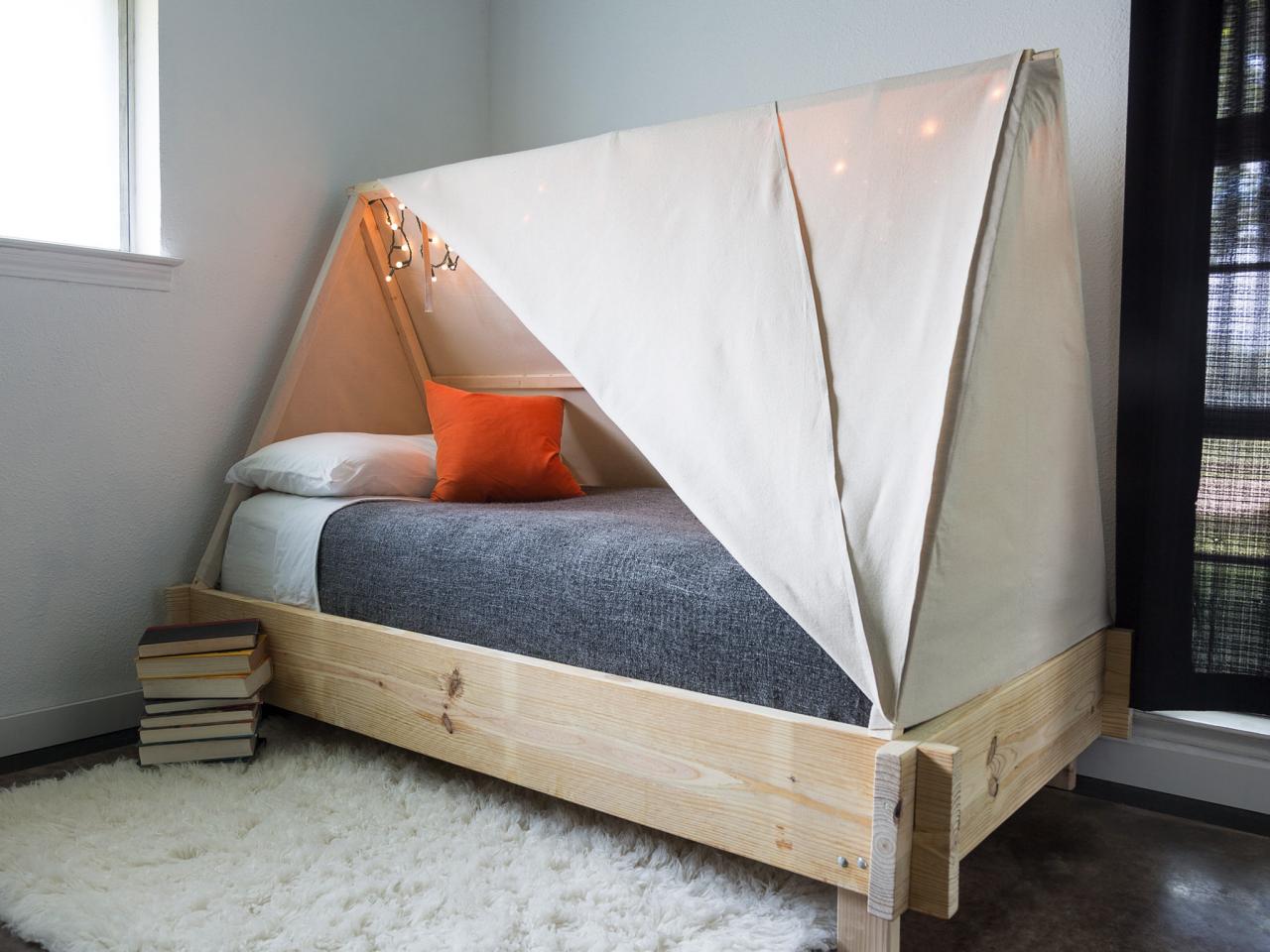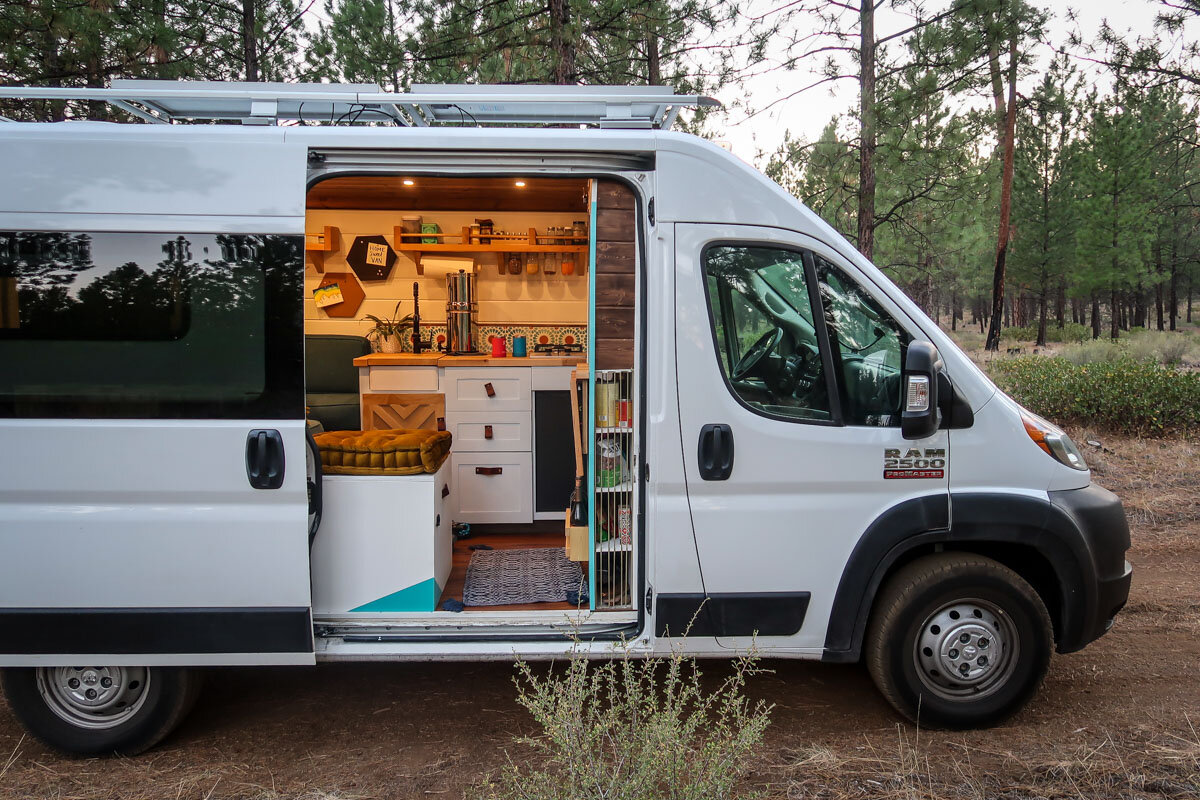Looking for homemade tent ideas? Tighten a string between two sturdy points and throw a sheet over it in an A-frame shape for a quick and simple tent setup.
Another option is to run a dowel under fabric and attach it to the ceiling using strings. If you don’t have a tent, you can use a large tarp by laying it on the ground and securing it with rocks.
You can buy a more permanent solution. materials and design your own tent with different fabrics for the panels, doors, windows, fly, and floor. DIY tent ideas can also be found on platforms like Pinterest and Reddit.

Credit: DIY crafts.life
1. Simple Homemade Tent Ideas
Tents are a great way to spark imaginations and create fun memories for kids. And the best part is you don’t have to spend a fortune to provide them with a cosy, homemade tent experience. Here are some simple and easy homemade tent ideas that you can try:
1.1 A-frame Tent
If you’re looking for a quick and easy setup, the A-Frame tent is a perfect choice. All you need is a string, two sturdy points to tie it between, and a sheet or blanket to throw over the top. The A-Frame shape will give it a classic tent look, and you can add some pillows or cushions inside to make it extra cosy. This is a great option for indoor or outdoor playtime.
1.2 No-sew Tent
No worries if you’re not the crafty type or don’t have a sewing machine! You can still create a homemade tent without any sewing. Simply lay a large tarp or blanket on the ground, tie a rope between two trees or posts, and drape the tarp over the rope. Use rocks or weights to secure the edges, and voila! You have a makeshift tent that can provide shade or shelter on a sunny day.
1.3 Diy Teepee
The teepee design is a classic choice for homemade tents. To make your own teepee, gather some long dowels or sticks, tie them together at the top, and spread the bottoms to create a triangular shape. Then, drape a large sheet of fabric over the frame and secure it with clips or clothespins. You can decorate the teepee with fairy lights or fabric garlands to make it even more enchanting.
1.4 Canvas Tent
You can try making a canvas tent if you’re feeling adventurous and have basic sewing skills. This type of tent provides durability and weather resistance for outdoor camping adventures. You’ll need to sew together panels of ripstop fabric for the tent body, mesh for doors and windows, and a waterproof taffeta for the fly and floor. Follow a tutorial or pattern to ensure you create a sturdy and functional canvas tent.
1.5 Modular Backyard Cabin Tent
For a more ambitious project, consider building a modular backyard cabin tent. Construct a frame using wooden beams or PVC pipes, and cover it with canvas or other weather-resistant fabric. To accommodate different activities, you can divide the space into different sections, such as sleeping quarters and a lounge area.
2. Materials And Construction
When it comes to creating your own homemade tent, choosing the right materials and construction techniques is essential. This ensures durability, comfort, and functionality. In this section, we will discuss the different aspects of materials and construction, including selecting the right fabrics, the tools and equipment needed, step-by-step instructions, tips and tricks, and safety considerations. Let’s dive in!
2.1 Choosing The Right Fabrics
Choosing the right fabrics is crucial for a successful homemade tent. The fabric should be sturdy, weather-resistant, and easy to work with. Here are a few options to consider:
- Ripstop Nylon: This fabric is lightweight, tear-resistant, and has a grid-like pattern that prevents rips from spreading.
- Polyesters: Polyesters are known for their resistance to wrinkles. quick-drying properties, making it a good choice for outdoor use.
2.2 Tools And Equipment Needed
Before starting your tent construction, ensure you have the necessary tools and equipment. Here are some essentials:
| Sewing Machine: | The process will be faster and more efficient with a sewing machine. Select a machine that is appropriate for heavy fabrics. |
| Scissors: | A good pair of scissors is essential for cutting fabrics and trimming threads. |
| Measuring Tape: | To ensure accurate measurements, have a measuring tape handy. |
| Thread: | Choose a high-quality thread that matches your fabric. |
| Grommet Kit: | A grommet kit will help you create reinforced holes for inserting poles or ropes. |
2.3 Step-by-step Instructions
Now, let’s walk through the step-by-step instructions for constructing your homemade tent:
- Sew the Panels: Use a sewing machine to join the fabric panels, reinforcing critical stress points.
- Add Doors and Windows: Create openings for doors and windows, and sew zippers or Velcro for easy access.
- Attach Poles and Ropes: Insert poles through grommeted holes and secure them with ropes to create a stable structure.
- Finish and Test: Double-check all seams and ensure everything is properly secured. Test your tent in a controlled environment before camping.
2.4 Tips And Tricks
Here are some helpful tips and tricks to keep in mind while constructing your homemade tent:
- Plan and Design: Plan and design your tent to ensure it meets your specific needs and preferences.
- Reinforce Stress Points: Reinforce critical stress points with extra stitching or fabric patches for added durability.
- Seal Seams: Use seam sealant to waterproof the seams and prevent leakage.
- Test Before Camping: Set up your tent in your backyard or a safe area to test its stability and identify any design adjustments needed.
2.5 Safety Considerations
While constructing your homemade tent, safety should always be a top priority. Here are some safety considerations:
- Fire Safety: Avoid using flammable materials near open flames or heat sources.
- Stability: Ensure your tent is properly secured to the ground to prevent it from collapsing during windy conditions.
- Ventilation: Incorporate ventilation openings in your tent design to prevent condensation buildup.
- Emergency Exits: Ensure your tent has multiple easily accessible exits.
Considering these materials, tools, step-by-step instructions, tips and tricks, and safety considerations, you’ll be well-equipped to create a homemade tent that suits your needs and provides a memorable camping experience. Happy tent-making!
3. Alternative Tent Solutions
Discover 3 alternative tent solutions for your homemade tent ideas in Austin, Texas. From DIY Kids Tents to easy reading nook tents, find the perfect option for your next camping adventure or backyard slumber party.
If you’re looking for alternative tent solutions beyond the traditional camping tents, we’ve got you covered. In this section, we’ll explore five unique homemade tent ideas that are perfect for various occasions and settings. These alternative tent solutions are creative and practical, from tarps to furniture repurposing.
3.1 Tarp Tent
One affordable and versatile option is the tarp tent. Start by tying a rope tightly between two sturdy points, such as trees or posts. Then, throw a large tarp over the rope in an A-frame shape. Secure the tarp with stakes or rocks to the ground and adjust the tension as needed. Add some pillows and blankets below, and voila – your homemade tarp tent is ready for camping adventures!
3.2 Furniture Fort Tent
If you’re looking for a fun indoor tent solution, consider repurposing your furniture into a fort tent. Simply gather your chairs, tables, and bed sheets. Use the furniture to create a sturdy frame and drape the bed sheets over them, securing them with clothespins or string. Add some cosy blankets, cushions, and fairy lights to create a magical hideaway in your living room.
3.3 Canopy Tent
A canopy tent is a great option for a stylish and practical outdoor tent solution. You can easily create a DIY canopy tent with just a few supplies. Start by constructing a frame using PVC pipes or wooden beams. Attach a durable fabric or tarp to the frame using zip ties or rope. Secure the tent to the ground with stakes or sandbags. This canopy tent provides shade and protection from the elements, making it perfect for outdoor parties, backyard gatherings, or even a cosy camping spot in your own backyard.
3.4 Temporary Indoor Tent
When you need a temporary indoor tent for a sleepover or a play area, buying expensive options is unnecessary. You can create a comfy retreat for your kids with basic items you can find at home. Use bed sheets or blankets to create a roof by draping them over furniture or attaching them to the walls with command hooks or clothespins. Add fairy lights, bean bags, and toys to create a magical indoor tent for hours of play and relaxation.
3.5 Diy Kids Play Tent
If you want to encourage imaginative play and creativity in your children, a DIY kid’s play tent is the perfect solution. Start by creating a simple wooden or PVC pipe frame shaped like a teepee or a playhouse. Attach colourful fabric or bed sheets to the frame using zip ties or string. Decorate the tent with their favourite toys, cushions, and even a mini chalkboard for personalized fun. This homemade tent will provide endless hours of entertainment and spark their imagination.

Credit: www.hgtv.com
4. Creative Tent Ideas
Discover creative homemade tent ideas for a fun DIY project in Austin, Texas. From simple no-sew setups to a-frame designs, explore unique ways to build your own tent for camping or for your kids to enjoy in the backyard.
4.1 Decorative Tent Designs
Homemade tents don’t have to be plain and boring. With some creativity and a few materials, you can design decorative tents that stand out. Incorporate colourful fabrics, fairy lights, and decorative elements to make the tent inviting and visually appealing for your kids.
4.2 Multi-purpose Tents
Explore the idea of creating multi-purpose tents that serve different functions. These tents can serve as play areas, reading nooks, or cosy nap spots. By adding versatile features such as detachable walls or adjustable openings, you can make the tent adaptable to various activities.
4.3 Unique Tent Concepts
Unleash your creativity by experimenting with unique tent concepts. Whether it’s a boat-shaped tent, a castle-inspired design, or a whimsical fairy tale theme, let your imagination run wild to create a one-of-a-kind tent for your little ones.
4.4 Upcycled Materials
Embrace sustainability by using upcycled materials to construct your homemade tent. Repurpose old bed sheets, curtains, or fabric remnants to minimize waste and give new life to these materials. Not only does this approach contribute to environmental conservation, but it also adds a unique touch to your tent design.
4.5 Fun And Colorful Tents
Inject a dose of fun and vibrancy into your homemade tents by incorporating bold colours and patterns. Brighten up the tent with playful decorations, such as bunting, pom-poms, or fabric garlands. Adding colourful elements can create an exciting and visually stimulating environment for your kids to enjoy.
5. Practical Considerations
When considering homemade tent ideas, there are several practical considerations to keep in mind to ensure the functionality and efficiency of the tent. From different environmental requirements to weatherproofing techniques and maintenance, here are the key practical aspects to consider.
5.1 Tent For Different Environments
Homemade tents should be versatile enough to withstand different environmental conditions, such as varying terrains and weather patterns. Consider the location and climate where the tent will be used, and tailor the materials and construction accordingly. For example, a tent for a hot and dry environment will require breathable fabric and sufficient ventilation, while a tent for a cold and wet environment must prioritize insulation and waterproofing.
5.2 Portable And Lightweight Designs
Portability and lightweight design are essential practical considerations for homemade tents. The tent should be easy to carry and set up, whether for camping, hiking, or other outdoor activities. Opt for compact and lightweight materials that can be easily transported, and consider modular designs that allow for easy assembly and disassembly.
5.3 Weatherproofing Techniques
Weatherproofing is crucial for homemade tents to ensure protection from the elements. Implement effective weatherproofing techniques such as seam sealing, waterproof coatings, and proper tent orientation to minimize the impact of rain, wind, and extreme temperatures. Additionally, consider features like storm flaps, vestibules, and well-designed rainflies to enhance weather resistance.
5.4 Comfort And Insulation
While focusing on practicality, it’s important to prioritize comfort and insulation in homemade tents. Incorporate features that enhance comfort, such as adequate padding, breathable materials, and proper ventilation. Insulation is essential for cold environments, so choose materials that offer insulation without compromising ventilation for a well-rounded homemade tent.
5.5 Tent Maintenance And Repair
Proper maintenance and repair considerations are necessary to prolong the lifespan of homemade tents. Ensure that the tent materials are durable and can withstand wear and tear. Additionally, provide guidelines for regular cleaning, storage, and repairs to maintain the tent’s functionality over time.

Credit: www.pinterest.com
Frequently Asked Questions On Homemade Tent Ideas
How Do You Make A Simple Tent At Home?
To make a simple tent at home, tighten a string between two sturdy points. Throw a sheet over it in an A-frame shape and add some pillows below. Another option is to run a dowel under fabric and attach it to the ceiling with strings.
No sewing is required.
How Do You Make A Tent Without A Tent?
To make a tent without a tent, you can create a simple setup by tightening a string between two sturdy points and throwing a sheet over it in an A-frame shape. Another option is to lay a large tarp on the ground beneath a rope, securing the edges with rocks.
Can You Make Your Own Tent?
Yes, you can make your own tent using sturdy fabric and basic materials available in the market.
How To Make An Indoor Tent For Adults?
To make an indoor tent for adults, use a string between two sturdy points. Then, throw a sheet over it in an a-frame shape and add pillows below for a cosy setup. Another option is to use a large tarp and rocks for a makeshift tent without an actual tent.
Conclusion
Creating your own homemade tent can be a fun and cost-effective way to enjoy outdoor activities.
Whether you choose to make a teepee-style tent or a simple A-frame structure, the possibilities are endless. So gather your materials and follow the easy steps; from the comfort of your own home, you can start enjoying the great outdoors. homemade tent. Let your imagination run wild and create an unforgettable experience for yourself or your children.
Happy tent-making!

